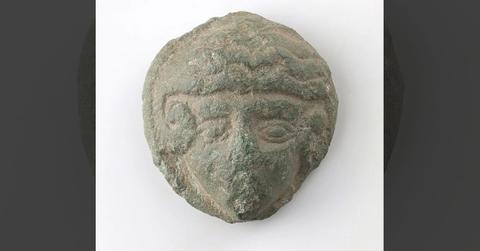Mini Marvel: 1,800-Year-Old Bronze Portrait of Alexander the Great Discovered in Danish Field

A miniature bronze portrait of Alexander the Great has been uncovered by metal detectorists on an island in Denmark.
A miniature bronze portrait of Alexander the Great has been uncovered by metal detectorists on an island in Denmark.
Finn Ibsen and Lars Danielsen made the remarkable discovery during a survey in a field outside Ringsted, a city on the Danish island of Zealand. They then turned the artifacts over to Museum West Zealand, as reported by the Danish news outlet TV2 Øst.
The bronze fitting, identified as a bracket, has a diameter of approximately 1 inch. It is made of a bronze alloy and features an engraved portrait of a man with wavy hair wearing a crown of twisted ram horns, according to a statement from Museum West Zealand.
Archaeologists immediately recognized the image as that of Alexander the Great, the renowned leader of the ancient kingdom of Macedon, whose empire stretched from the Balkans to modern-day Pakistan before he died at the age of 32.
The piece “has the typical attributes of Alexander the Great, such as his distinct, wavy hair and ram horns," said Freerk Oldenburger, an archaeologist at Museum West Zealand, speaking to Live Science. "The image is almost identical to another bracket portrait found years ago that contains the same stylized image."
This previous piece, also a metal bracket, was discovered by a different group of archaeologists in Jutland, Denmark. It was found among a cache of weapons and likely served as an "ornament worn on a silver shield mount — it was a way to show off," Oldenburger explained.
- What Lies Beneath: NASA Scientist Believes Aliens May Have Found 'Perfect' Hiding Spot in Earth's Oceans
- Global Threat: Russia Insider Warns West of 'World War Using Nuclear Weapons' Amid Escalating Support for Ukraine
- Countdown to Disaster? Ex-NATO Official Warns Russia, Iran and China Could Wage WWIII in Just Years
"It's quite a remarkable piece," Oldenburger said. "When it showed up on my desk, I nearly fell out of my chair because it's almost the exact same portrait as the other, but this one is a little more coarse and is made of cast bronze and not gilded silver. The bronze alloy also contains a high lead content and was made using an alloy often found in [Roman] bronze statuettes. It's possible that a statuette was melted down to make this portrait."
Although researchers are unsure of the piece's function, they believe the fitting dates to around A.D. 200 and could have been worn as a "decorative disc for a shield" or as a bracket affixed to a sword belt, according to the statement.
Never miss a story — sign up for the Front Page Detectives newsletter. Be on the scene the moment news breaks.
"This was around the same time as Caracalla," a Roman emperor who reigned from A.D. 198 to 217 and “was completely obsessed with Alexander the Great and was interested and inspired by him, since he was the greatest conqueror of that time period," he added.
Become a Front Page Detective
Sign up to receive breaking
Front Page Detectives
news and exclusive investigations.
